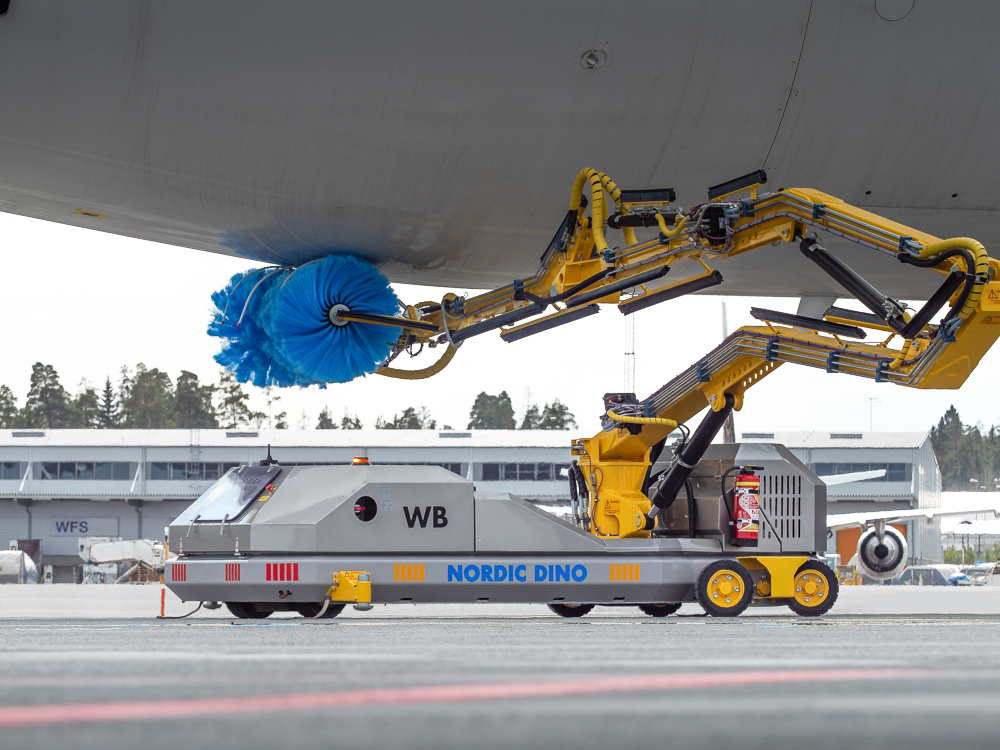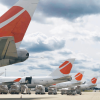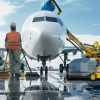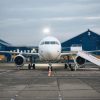 The advanced aerodynamic efficiency and inclusion of advanced avionics systems in modern aircraft design have increased the requirement and benefits of aircraft cleaning. While aerodynamic efficiency has reduced operating cost and use of flight instruments have added to safety, both benefits are vulnerable to contamination from aircraft dirt. With great increases in the severity of ramifications from contaminations on flight surfaces and avionic sensors, Nordic Dino, the world’s leading automated aircraft washing solutions designer and a subsidiary of Avia Solutions Group, explains the relationship between aircraft exterior hygiene and performance and functionality of aircraft.
The advanced aerodynamic efficiency and inclusion of advanced avionics systems in modern aircraft design have increased the requirement and benefits of aircraft cleaning. While aerodynamic efficiency has reduced operating cost and use of flight instruments have added to safety, both benefits are vulnerable to contamination from aircraft dirt. With great increases in the severity of ramifications from contaminations on flight surfaces and avionic sensors, Nordic Dino, the world’s leading automated aircraft washing solutions designer and a subsidiary of Avia Solutions Group, explains the relationship between aircraft exterior hygiene and performance and functionality of aircraft.
“Contamination has had a pronounced and measured effect on flight safety and the efficiency of an aircraft’s design.” Veronika Andrianovaite, Chief Commercial Officer (CCO) of Nordic Dino Robotics AB, said. “While we have worked hard to design a fully automated, high-tech solution to aircraft hygiene, the effect of dirtiness on an aircraft's skin and flight surfaces has been well understood since the physics of flight were first discovered,”
The effect of contamination and subsequent blockage of sensors means that aircraft cleanliness has always been an important part of pre-flight inspections and aviation maintenance practices. Aircraft manufacturers and airline flight departments all have recommendations for pilots to walk around the aircraft prior to departure to visually inspect the condition of sensors on the aircraft to ensure they will function properly during flight.
“Aircraft cleanliness is a requirement of preflight checklist procedure to ensure aircraft sensors feed avionics appropriate information during the flight,” Andrianovaite said. “If these sensors become blocked, clogged, or damaged as a result of debris buildup on an aircraft skin, this can have serious and alarming repercussions to the complex computer systems required to operate aircraft.”
For example, aircraft will be equipped with what is known as a pitot-static system in order to generate important information on airspeed and altitude. These sensors will require holes fitted to aircraft to detect air pressure and feed this information into an air data computer. While there are differences in how these systems work in general aviation and commercial airliners, the protection of these systems is key to ensure functionality on every aircraft.
“Pilots are trained to examine the ports of these sensors for blockage because the failure of these systems as a result of blockage has resulted in accidents and loss of life,” Andrianovaite said. “Due to the nature of flight, the cleanness of the entire aircraft is important to protect these sensors, because dirt and fluid from one location can move to another location easily in flight.”
Demonstrating the importance of preventing failure of these systems, Aviation Safety Magazine reported that 65 % of the reported accidents due to pitot system abnormalities in general aviation were the direct result of contamination of the pitot tube. Scaling up to commercial aviation, 1996 saw two deadly accidents in the same year with Birgenair Flight 301 and Aeroperú Flight 603 claimed 259 souls as a result of blockage of pitot-static systems.
Parasite drag
The contamination of flight surfaces also changes the fundamental physical forces acting on an aircraft during flight. The change in force on dirty aircraft begins with how the wing of an aircraft generates lift. The force of lift comes from pressure differences that are created by the change in airspeed as air moves around the aircraft. This change in airspeed will be interrupted by minute changes on the surface of the aircraft, as contamination will disrupt the flow of air molecules, slowing them down as they are moving across the surface of the airplane. This effect spoils lift generated by the wing, thus creating small changes in potential lift.
Restrictions in airflow are known as drag. Drag counteracts the force of thrust generated by an aircraft's engines, and force of lift generated by a wing. While certain elements of drag are induced by the airflow around the wing that are inevitable to any design, engineers have designed aircraft to avoid as much drag as possible.
“In the case of drag, contamination is a leach on the performance of an airfoil, and an addition to parasite drag generated in flight,” Andrianovaite said. “Allowing an aircraft to become dirty can add to parasite drag in a matter that detracts from the thousands of dollars of efficiency of aircraft that engineers have worked so hard to deliver.”
In a 1990 study of fuel efficiencies of two aircraft on trans-atlantic flight, the difference in fuel burn between clean aircraft and dirty aircraft amounted to half a ton of fuel savings. Similar studies by aircraft manufacturer McDonnell Douglas in the same time period indicated 1.5% less fuel burn on aircraft with smoother surfaces in a 90-minute flight.
“Translating the fuel savings of these studies into dollars with today’s price of fuel, they amount to nearly $357 dollars per 8 hours of flight according to fuel cost measured by IATA’s fuel price analysis in the first week of September,” Andrianovaite said. “The 1.5% less fuel burn from the McDonnell Douglas study would save approximately $50 from the cost of fuel to fly from Frankfurt to London.”
With effects on both aerodynamics and aircraft instrumentation, the cleanest of aircraft flight surfaces and avionics has a dramatic effect on aircraft performance and functionalities. Maintaining exterior condition of aircraft with robust and efficient cleaning schedules therefore has incredible benefits for operating cost for airlines, and potential savings of life from the contribution to flight safety.
Nordic Dino Robotics is part of the Avia Solutions Group family, the world’s largest ACMI (Aircraft, Crew, Maintenance, and Insurance) provider, with a fleet of 214 aircraft, and a parent company of SmartLynx, Avion Express, BBN Airlines Indonesia, KlasJet, Magma Aviation and more.





